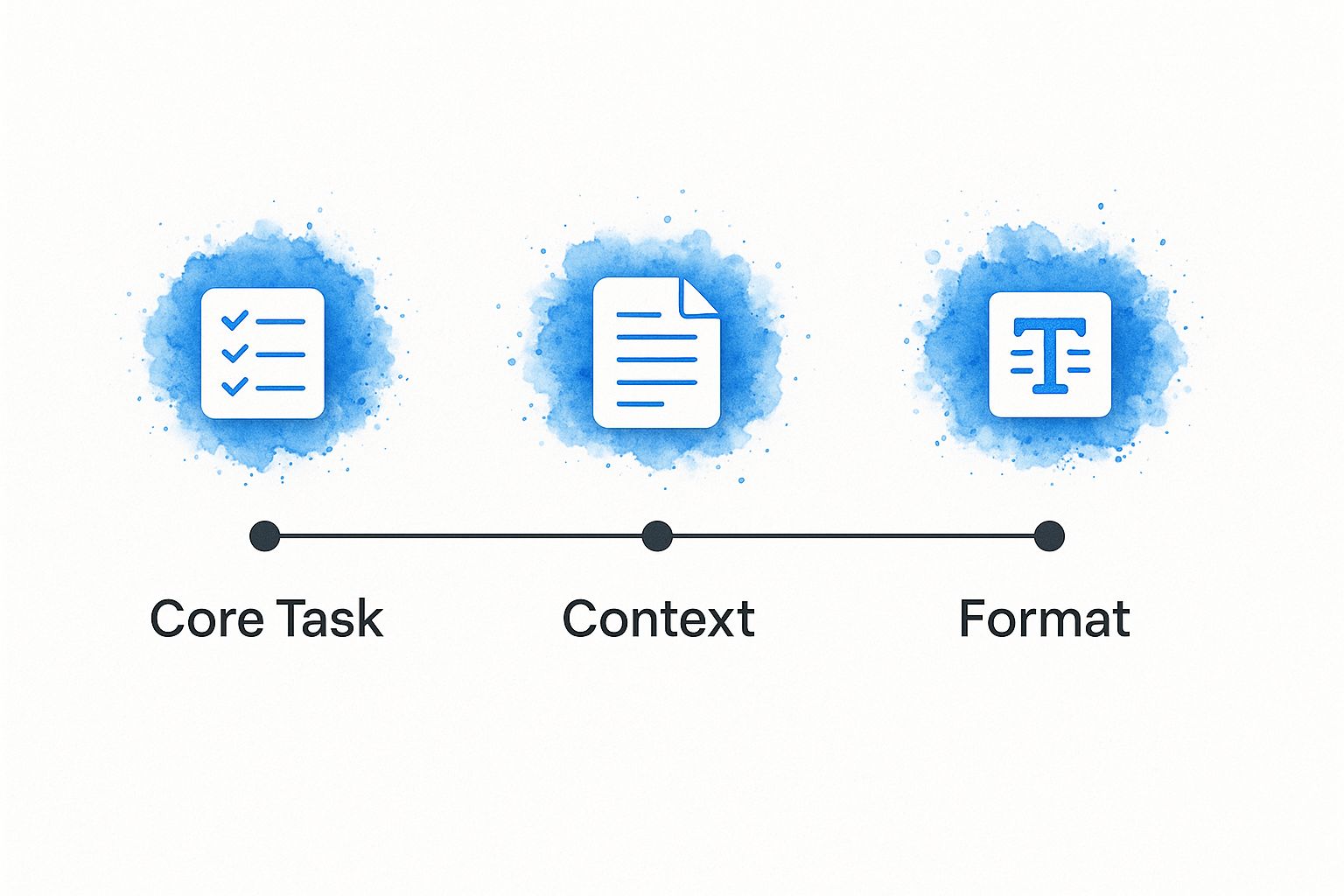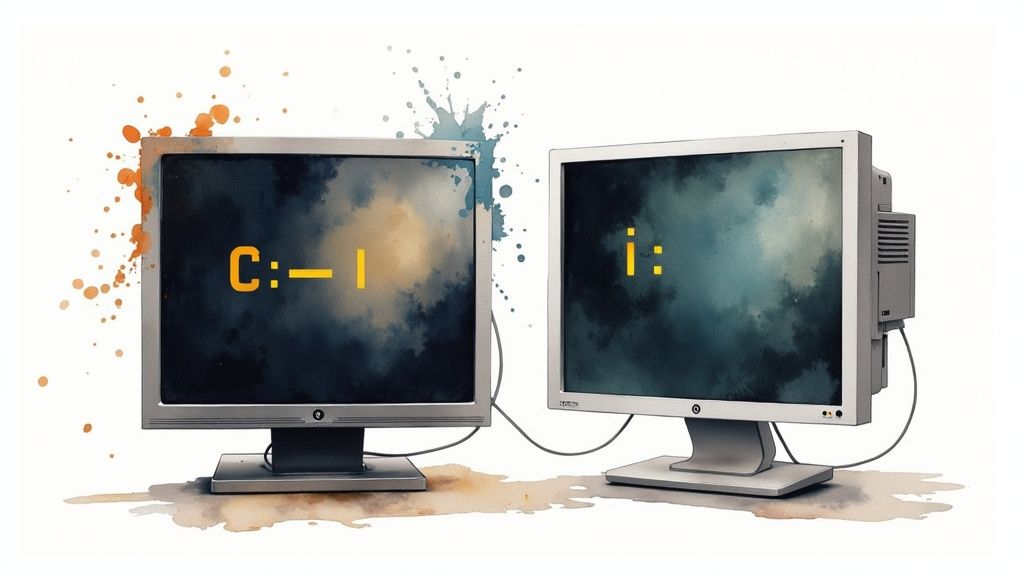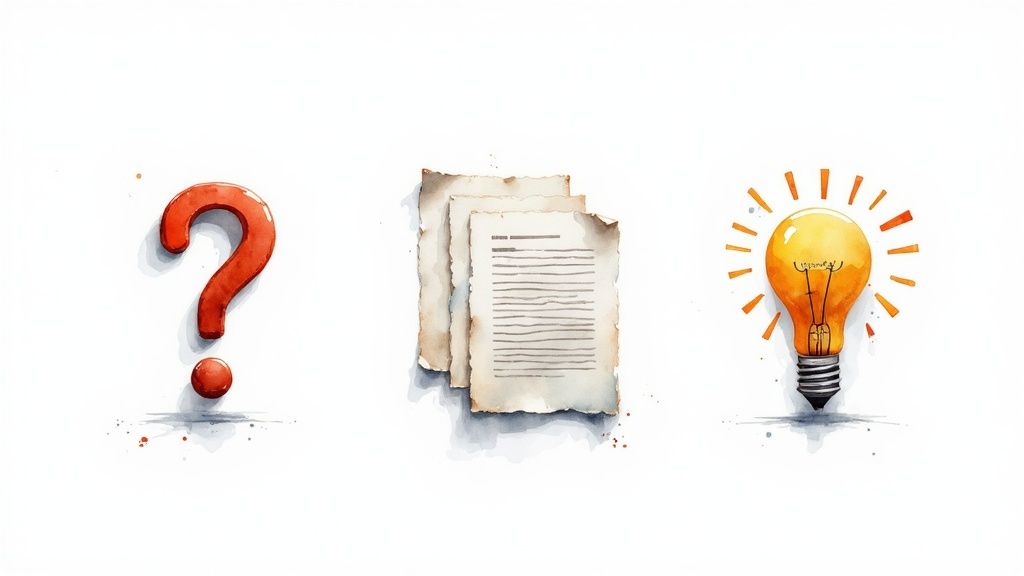What Does Prompt Mean? An Insider's Guide to AI

At its core, a prompt is really just a set of instructions you give an AI. It’s the question you ask, the command you give, or the context you provide to get it pointed in the right direction.
Think of it like giving a skilled but very literal assistant a clear to-do list. The more specific you are, the better the result.
Decoding Your First AI Prompt
To really get what a prompt is, we need to move past that simple definition. Imagine you’re talking to a brilliant artist who can paint anything you want, but they need you to describe your vision perfectly. A vague request like "paint a landscape" will get you a landscape, but probably not the one you were picturing.
This is exactly how AI works. The quality of your input directly shapes the quality of its output.
A good prompt isn't just a question. It's a carefully constructed piece of instruction that tells the AI not only what to do but also how to do it. Digging into what makes a prompt truly effective means getting familiar with the underlying principles of Natural Language Processing (NLP), which is the magic that lets computers understand human language in the first place.
The Building Blocks of a Prompt
Every solid prompt has a few key ingredients. It’s less about some single magic phrase and more about combining clear components to build a solid instruction. For instance, instead of just asking, "Tell me about dogs," a much more powerful prompt would be something like, "Write a 100-word summary about the loyalty of golden retrievers, written for a fifth-grade audience."
See the difference? That second one is going to get you a much more useful result.
This infographic breaks down the three core milestones of crafting a strong prompt into a simple flow.

This simple progression—from Task to Context to Format—is what turns a fuzzy idea into a specific, actionable command the AI can actually work with.
To make this crystal clear, let's break down the anatomy of a basic prompt into its most critical parts. Once you learn to spot these components, you can start building more intentional and effective prompts right away.
Anatomy of a Basic AI Prompt
Here’s a simple table breaking down the core components that make up an effective instruction for an AI model.
| Component | Its Role in the Conversation | Simple Example |
|---|---|---|
| Core Task | The main action you want the AI to perform. | "Write an email" |
| Necessary Context | The background info the AI needs to complete the task well. | "...to my team about the upcoming project deadline." |
| Desired Format | The specific structure, style, or constraints for the output. | "Keep it professional, under 150 words." |
Thinking in these three parts—Task, Context, and Format—is the first step toward getting consistently better results from any AI you work with.
The Journey From Command Line to Conversation
To really get what a modern AI prompt is, we have to look back at where it came from. The idea isn't brand new, but it has changed in ways we could have hardly imagined. Decades ago, a prompt was nothing more than a blinking cursor on a black screen, waiting for your next command: C:\>.

Those early prompts were incredibly rigid. They demanded absolute perfection. You had to memorize exact commands with precise syntax, and a single misplaced character or typo would send you right back to square one. There was zero room for error or natural language—it was a one-way street of strict, unforgiving instructions.
From Commands to Communication
As technology marched forward, so did the prompt. The real shift kicked off in the 2010s with the rise of natural language processing (NLP) and machine learning. Suddenly, computers were starting to understand human language, not just code.
This was a game-changer. The word "prompt" transformed from a simple command-line input into a sophisticated instruction designed to coax the best possible performance out of generative AI.
Now, the modern AI prompt is all about conversation. Instead of memorizing syntax, the challenge lies in mastering the art of clear communication. This has opened up entirely new ways to work with AI. Exploring the launch of the ChatGPT GPT Store shows just how far we’ve come—from basic commands to a whole marketplace of specialized AI assistants, all powered by prompts.
Today, prompting is less about being a programmer and more about being a great communicator. It’s a creative skill focused on translating human intent into instructions an AI can act upon effectively.
The New Skill of Prompting
This journey highlights a fundamental change in how we interact with technology. We’ve gone from a world where we had to learn the machine's language to one where the machine is learning ours.
So, what does this evolution mean for you? It means your ability to ask clear, contextual questions is now an incredibly powerful skill. Crafting a great prompt has become a unique blend of logic and creativity, paving the way for a more intuitive and powerful future of human-AI collaboration.
Exploring Different Prompting Techniques

Not all prompts are created equal. Once you get the hang of the basics, you can start using more strategic techniques to get far more nuanced and accurate results from an AI. Picking the right approach is often the difference between a generic, forgettable answer and a truly insightful one.
Think of these techniques as different tools in a toolbox. A simple question might just need a basic instruction, but tangled, complex problems demand a more thoughtful method. Learning these strategies will dramatically level up the quality of your AI interactions.
Zero-Shot Prompting
The most common technique is Zero-shot prompting. This is where you ask the AI to do something without giving it any examples to follow. You’re relying entirely on the model's massive library of pre-existing knowledge to figure out what you want and generate a relevant response. It’s the simplest way to get an answer, period.
For instance, asking an AI to "Summarize the plot of Hamlet" is a classic zero-shot prompt. You just state the task and the subject, then trust the AI to run with it based on its training.
This approach works perfectly for straightforward tasks, general knowledge questions, and creative brainstorming where you want the AI to have maximum freedom. But for more specific or highly formatted outputs, you’ll need to give it a bit more guidance.
A prompt is more than an instruction; it's a way of thinking that guides an AI toward a desired outcome. The better you can articulate your thought process, the better the AI can mirror it.
Few-Shot Prompting
When you need more control over the output, Few-shot prompting is your go-to method. With this technique, you give the AI a handful of examples of the task done correctly before making your actual request. This helps the model lock onto the specific pattern, style, or format you're looking for.
It's like showing a new assistant a few perfectly written reports before asking them to draft a new one. The examples set a clear standard.
Here's how that looks in practice for sentiment analysis:
- Example 1:
- Input: Text: "This movie was fantastic!" Sentiment: Positive
- Input: Text: "This movie was fantastic!" Sentiment: Positive
- Example 2:
- Input: Text: "I was really disappointed." Sentiment: Negative
- Input: Text: "I was really disappointed." Sentiment: Negative
- Your Request:
- Input: Text: "The acting was superb, but the story was weak." Sentiment:
- Input: Text: "The acting was superb, but the story was weak." Sentiment:
By providing examples, you guide the AI to produce a more consistent and predictable result. This makes it ideal for tasks like data classification, sentiment analysis, or matching a specific writing tone.
Chain-of-Thought Prompting
For complex problems that require real reasoning, Chain-of-Thought (CoT) prompting is a seriously powerful technique. Instead of just asking for the final answer, you instruct the AI to "think out loud" and explain its reasoning step-by-step.
This simple tweak forces the model to break down a complicated problem into smaller, logical pieces. The results are striking—it significantly improves accuracy on math problems, logic puzzles, and any multi-step question. It’s like asking a student to show their work on a math test; you’re not just looking for the right answer, but the process that got them there.
How to Craft Prompts That Get Amazing Results
Moving from simple questions to thoughtfully constructed commands is where you really start to unlock what AI can do. The secret isn't some magic word; it's a practical structure built on four pillars: Clarity, Context, Specificity, and Persona. Getting these right will transform a vague idea into a precise instruction that delivers great results, time and time again.
Think of it this way: asking an AI to "write about marketing" is like telling a world-class chef to "make some food." You'll get something, but it's a total gamble whether it's the meal you were craving. Giving clear, detailed instructions is the only way to ensure the final product is exactly what you had in mind.
The Four Pillars of Prompt Design
A killer prompt gives the AI a complete blueprint for success. When your prompts are vague, the AI has to guess what you want, which almost always leads to generic, uninspired output. Your job is to take the guesswork out of the equation by being completely explicit about what you need.
A huge part of this is learning to treat the AI less like a search engine and more like a skilled, eager-to-please intern. For instance, assigning a persona is a surprisingly powerful technique. Just starting your prompt with, "You are a professional copywriter," immediately frames the entire response with a specific tone and level of expertise. The results are worlds better than a generic request.
For a deeper dive into this discipline, our guide to mastering AI prompt engineering offers more advanced tips and tricks.
A well-crafted prompt doesn't just ask a question. It defines a role, sets a scene, and specifies exactly what you want the AI to produce. This simple shift turns the AI from a passive tool into an active creative partner.
Checklist for Crafting a Powerful Prompt
To make this super practical, here’s a simple checklist. Think of it as a pre-flight check before you hit "generate." Each element you add narrows the AI's focus and steers it much closer to your target, ensuring you've included all the essential ingredients for a high-impact prompt.
This table breaks down a simple framework to guide you.
Checklist for Crafting a Powerful Prompt
| Element | Why It Matters | Example |
|---|---|---|
| Persona | Assigns a role to the AI for a specific tone and expertise. | "You are an expert travel blogger..." |
| Audience | Defines who the output is for, shaping language and complexity. | "...writing for budget-conscious solo travelers." |
| Goal | Clearly states the primary objective of the task. | "The goal is to inspire them to visit Kyoto." |
| Format | Specifies the structure, length, or style of the response. | "Create a 300-word blog post with bullet points." |
By running through these four elements—even just mentally—before you write your prompt, you dramatically increase the odds of getting a high-quality, relevant, and useful response on the very first try.
The Rise of the Prompt Engineer
Understanding what a prompt is has quickly become more than just a neat party trick—it’s the backbone of a new, highly sought-after profession. As AI weaves its way into just about every business process, a new kind of expert has stepped up to bridge the gap between human ideas and machine output.

Meet the prompt engineer.
A prompt engineer is a specialist who architects, polishes, and perfects the instructions we feed to AI models. Their whole job is to push the AI to its limits, coaxing it into producing the most accurate, creative, and genuinely useful results possible. Think of them as part translator, part creative director, and part detective, all rolled into one.
A New Career Landscape
This isn't some niche hobby; it's a full-blown career path that's growing at an incredible pace. Companies are willing to pay top dollar for people who can translate complex goals into language an AI understands. That demand shows just how much value expert-level prompting can create, whether it’s for generating laser-focused marketing copy or writing intricate lines of code.
This new field is also a global one. A recent analysis of the AI job market found that prompt engineering roles are popping up in major tech hubs, with the United States leading the charge at 31.7% of jobs. India follows at 18.1%, and the United Kingdom comes in at 7.2%.
The same data gives us a peek into what it takes to land one of these roles. While AI knowledge (22.8%) and prompt design skills (18.7%) are obviously key, sharp communication abilities (21.9%) and creative problem-solving (15.8%) are just as critical. You can dig deeper into the numbers and trends in this detailed study on the rise of the prompt engineer.
A prompt engineer doesn’t just tell an AI what to do. They understand the model’s quirks and blind spots, crafting instructions that steer it around its limitations to achieve something truly exceptional.
Getting good at writing prompts isn't just a skill—it's a ticket to some of the most exciting professional opportunities out there, placing you right at the heart of human-AI collaboration.
Where Prompts and AI Are Headed Next
The way we talk to artificial intelligence is changing—and fast. Right now, we mostly rely on text, but the future of what a "prompt" even is will be far more immersive and intuitive. We're quickly moving toward a multi-modal world where your instructions won't just be typed words.
Imagine feeding an AI an image, a voice command, and a short video clip all at once to get it to create something new. This kind of input blending will make collaborating with AI feel much more natural, simplifying even the most complex creative tasks. You can get a glimpse into some of these AI prompt breakthroughs and trends to see just how quickly the ground is shifting beneath our feet.
The Economic Boom of Prompting
This isn't just a fascinating tech trend; it's a massive economic one, too. The field of prompt engineering is absolutely exploding as businesses wake up to the value of getting human-AI interaction right.
The global market for prompt engineering was valued at a cool USD 222.1 million in 2023. But get this—it's projected to rocket to USD 2.06 billion by 2030. That's a compound annual growth rate of 32.8%, all fueled by the demand for smarter AI in everything from healthcare and finance to e-commerce.
As AI tools weave their way into our daily routines, their effect on user engagement is a telling sign of what's to come. We're already seeing this play out in discussions around things like ChatGPT referral traffic.
At the end of the day, the humble prompt is the steering wheel for artificial intelligence. Mastering the art of crafting a clear, contextual prompt is no longer some niche technical skill. It's quickly becoming a fundamental ability for anyone looking to navigate the future.
Got Questions About Prompts?
Let's clear up a few things. These are some of the most common questions I hear from people just getting started, and the answers should help lock in what you've learned so far.
Is There a Perfect Length for an AI Prompt?
Nope, there's no magic number. A simple task might only need a single sentence. But if you're asking for something complex, with a specific tone of voice and a particular format, you might end up writing a few paragraphs.
The real key isn't length, but clarity. Your goal is to be as concise as you can while still giving the AI all the context it needs to get the job done right.
What's the Biggest Mistake People Make When Writing Prompts?
Without a doubt, it's being too vague. AI models are incredibly powerful, but they aren't mind readers. A lazy prompt like "write about marketing" is a recipe for a generic, uninspired response.
Specificity is everything. You have to spell out what you want. Who is the audience? What's the goal of the piece? How should it be structured? The more specific you are, the better your results will be.
Can You Use Prompts for More Than Just Text?
Absolutely. While we often talk about prompts in the context of text generation, the same core principle applies across all kinds of generative AI.
You use text prompts to create stunning images in tools like Midjourney or DALL-E, to generate functional code, compose original music, and even produce short video clips. No matter the medium, it all starts with the same idea: giving the AI clear, effective instructions.
Ready to stop guessing and start creating? Find your next great prompt on PromptDen. Explore thousands of community-tested prompts today.